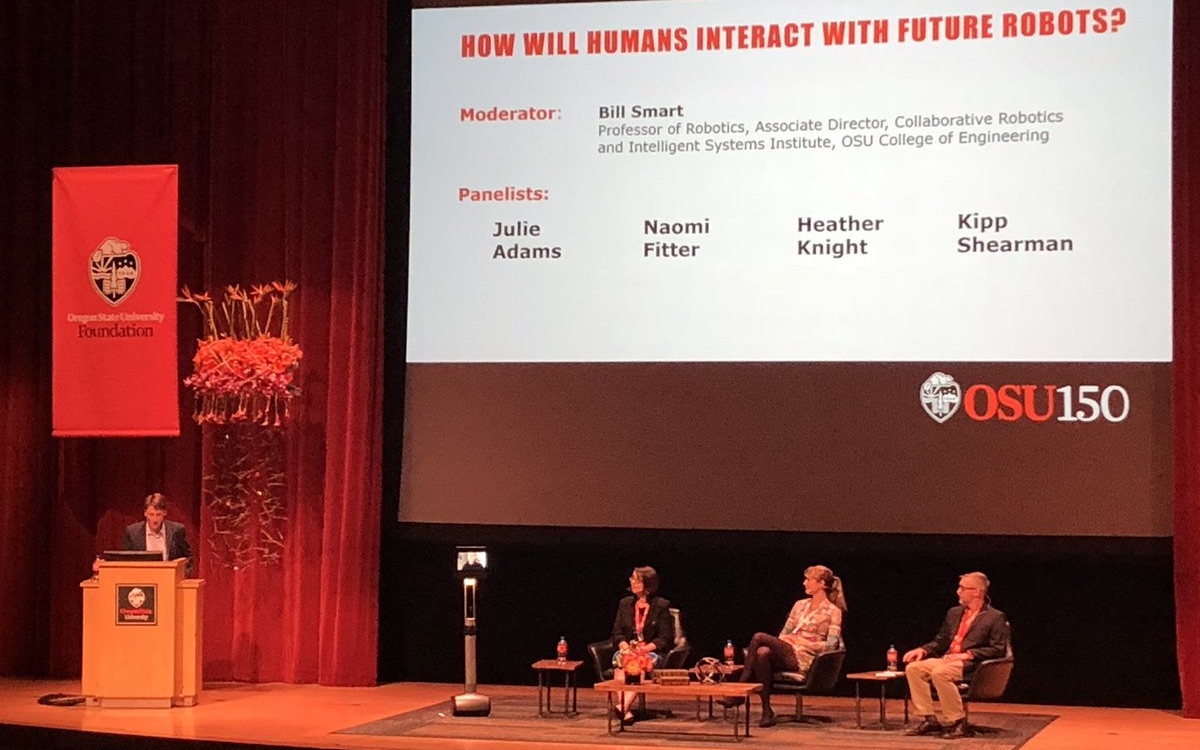Outreach
Sharing our work with the research community, local events, and beyond

Scientific Communication
Could cursing robots be the cathartic, anti-paternalistic advance we all need in 2025? Read our IEEE Spectrum article for more on why and how to study robots with dirty mouths.
We regularly present to the local Academy for Lifelong Learning, including a past hands-on workshop focused on building and programming a modular robot, as well as a visit to discuss flaws of current robotic systems and how to deal with them.
From Mr. Zed to Saturday Night Live’s Laughintosh 3000, “robots” have been entertaining viewers for decades. But how does true autonomous robot comedy work? Take a look at the IEEE Spectrum article for more on the tricks of the trade.
As robots become part of our daily lives, many people will expect them to participate in a variety of social touch interactions, including clapping games and, of course, high fives! Check out our IEEE Spectrum article to learn more.
Prof. Fitter offered views of the future of human-robot interaction alongside other leading HRI researchers from the CoRIS Institute as part of the OSU150 symposium on AI and robotics.
Robot Exhibitions
During the 2025-26 season, Prof. Fitter will run a series called “STEM Cabaret” with the new Patricia Valian Reser Center for the Creative Arts (PRAx) on campus. Visit the center’s page for more information on dates and ticketing.
Jon the Robot has headlined comedy shows since 2018, including appearances at the Eugene Comedy Scene’s RoboCom show and several academic conferences (RO-MAN 2024, ICRA 2025, RSS 2025). We have a blast joining these comedy shows with some of the nerdiest human comics out there.
Our research group runs a robot comedy variety show called Singu-hilarity at The Majestic, a long-standing theater in downtown Corvallis. Check the following website to see when it is running next: majestic.org!
The week of our first Singu-hilarity show, the second generation of our wall-plotting robot interacted with visitors to The Majestic’s gallery. Visitors to the April art walk made collaborative generative art with the robot.
Open Source Tools
We observed multiple benefits of a robot eye display on the Hello Robot Stretch robot, and now you can, too! Build and deploy your own robot eyes using the repo linked in the title. This work is part of the ICRA 2025 paper: “Seeing Eye to Eye: Design and Evaluation of a Custom Expressive Eye Display Module for the Stretch Mobile Manipulator.””
You’ve read our research, and you know how important sound profiles are to the reception of robotic systems. Now, try altering robot sound for yourself! This repository was released with our RA-L/IROS 2022 paper: “SonifyIt: Towards Transformative Sound for All Robots.”
Skilled social robots should be able to read the room and work the crowd, but few open-source datasets exist for training things like laughter detection models. This dataset offers real-world performance recordings, as detailed in our ICRA 2021 paper “A Robot Walks into a Bar: Automatic Robot Joke Success Assessment.”
Interested in trying your hand and making an art robot? Give it a try based on our open-source art robot repository from the ICRA 2020 paper: “May I Draw Your Attention? Initial Lessons from the Large-Scale Generative Mark Maker.”
In need of a fun workout? Try the human-Baxter exercise games discussed in our PREC workshop paper at HRI 2018 for yourself. See the social and physically-interactive games in action here.
How do people move when they play hand-clapping games like pat-a-cake? This dataset of hand motion recordings gives us a clue, as discussed in our IROS 2016 paper: “Using IMU Data to Demonstrate Hand-Clapping Games to a Robot.”
Make your Baxter (or other screen-faced robot) more expressive with this set of expressions. These faces were validated in the 2016 ICSR paper: “Designing and Assessing Expressive Open-Source Faces for the Baxter Robot.”
